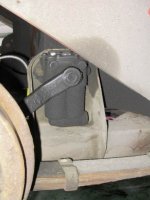Hi George,
I don't know if it's feasible to rebuild Armstrong levers at home. I don't know of anyone offering rebuild kits and you'd probably need some specialized tools to do much more than change the valves and oil.
First of all, are you sure they really need rebuilding? Often all that's needed is a change of oil. That's pretty easily done.
Unless the shock is leaking excessively at the shaft or top cover, I'd first try oil replacement and see if the lever action smooths out. Incidentally, I think the shaft is designed to leak slightly, so that any dust or dirt is moved outward.
Oil replacement can be done without removing the top (which would need a new seal). Just carefully remove the valve at the bottom to drain. I say carefully (and slowly) because there are several small parts and springs in there that need to be reinstalled in a specific order.
Next remove the filler screw at the top. Let it drain in a pan for a while. Once empty, put the valve back in snugly. Place the shock upright in a vise and refill it with proper oil. Moss sells shock oil. Or, a motorcycle shop will have fork oil that will work. Fork oil comes in various weights, too, if you want to change dampening characteristics. I think 20W was the original weight, but it seems that shock and fork oil weights aren't consistent from on manufacturer to another. Might need to experiment a little.
Once the shock is full, work the lever by hand, up and down a number of times. You'll probably feel some roughness in the stroke initially, but that should go away as air is worked out of the valving. Shock resistance should be smooth and consistent over both up and down strokes. If it continues to be rough and/or uneven, there might be internal wear, damage or dirt that means you'll need to replace the shock. It's possible that just a replacement valve would solve the problem, but that's would be an expensive experiment if it doesn't resolve the problem, so it might be wise to just get a rebuilt set.
If you really need to replace, have you checked out Apple Hydraulics? Their prices for rebuilt Armstrongs seem pretty good. They also offer heavy duty upgrades if you are interested.
www.applehydraulics.com
While in there working on shocks, unless they are relatively new I'd suggest replacing the links. They seem to wear out much more often than the lever shocks themselves.
Hope this helps!
Alan Myers
San Jose, Calif.
'62 TR4 CT17602L

 Hi Guest!
Hi Guest!

 smilie in place of the real @
smilie in place of the real @
 Pretty Please - add it to our Events forum(s) and add to the calendar! >>
Pretty Please - add it to our Events forum(s) and add to the calendar! >> 
